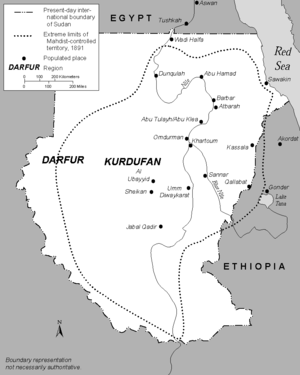
Valentine Baker, was a British soldier, and a younger brother of Sir Samuel Baker.

Muhammad Ahmad bin Abdullah bin Fahal was a Sudanese religious and political leader of Nubian descent. In 1881, he claimed to be the Mahdi, and led a successful war against Egyptian rule in Sudan which culminated in the victorious siege of Khartoum. He created a vast Islamic state extending from the Red Sea to Central Africa, and founded a movement that remained influential in Sudan a century later.

Vice-Admiral Sir William Nathan Wrighte Hewett, was a Royal Navy officer and a recipient of the Victoria Cross, the highest award for gallantry in the face of the enemy that can be awarded to British and Commonwealth forces. The Hewett Treaty is named after him.

The Battle of Abu Klea, or the Battle of Abu Tulayh took place between 16 and 18 January 1885, at Abu Klea, Sudan, between the British Desert Column and Mahdist forces encamped near Abu Klea. The Desert Column, a force of approximately 1,400 soldiers, started from Korti, Sudan on 30 December 1884; the Desert Column's mission, in a joint effort titled "The Gordon Relief Expedition", was to march across the Bayuda Desert to the aid of General Charles George Gordon at Khartoum, Sudan, who was besieged there by Mahdist forces.

The Siege of Khartoum took place from 13 March 1884 to 26 January 1885. Sudanese Mahdist forces captured the city of Khartoum from its Egyptian garrison, thereby gaining control over the whole of Sudan.
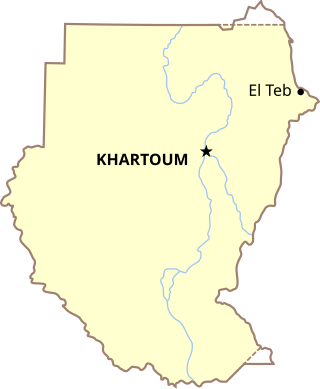
El Teb, a halting-place in the Anglo-Egyptian Sudan near Suakin on the west coast of the Red Sea, 9 m. southwest of the port of Trinkitat on the road to Tokar.

Osman Digna was a follower of Muhammad Ahmad, the self-proclaimed Mahdi, in Sudan, who became his best known military commander during the Mahdist War. He was claimed to be a descendant from the Abbasid family. As the Mahdi's ablest general, he played an important role in the fate of General Charles George Gordon and the end of Turkish-Egyptian rule in Sudan.
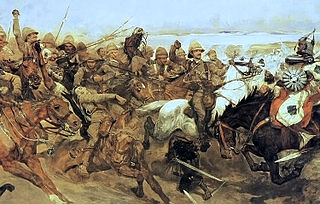
The Mahdist War was a war between the Mahdist Sudanese, led by Muhammad Ahmad bin Abdullah, who had proclaimed himself the "Mahdi" of Islam, and the forces of the Khedivate of Egypt, initially, and later the forces of Britain. Eighteen years of war resulted in the creation of Anglo-Egyptian Sudan (1899–1956), a de jure condominium of the British Empire and the Kingdom of Egypt in which Britain had de facto control over Sudan. The Sudanese launched several unsuccessful invasions of their neighbours, expanding the scale of the conflict to include not only Britain and Egypt but also the Italian Empire, the Congo Free State and the Ethiopian Empire.

The Battle of Toski (Tushkah) was part of the Mahdist War. It took place on August 3, 1889 in southern Egypt between the Anglo-Egyptian forces and the Mahdist forces of the Sudan.

The Battle of Tamai took place on 13 March 1884 between a British force under Sir Gerald Graham and a Mahdist Sudanese army led by Osman Digna.

The Nile Expedition, sometimes called the Gordon Relief Expedition (1884–1885), was a British mission to relieve Major-General Charles George Gordon at Khartoum, Sudan. Gordon had been sent to Sudan to help the Egyptians withdraw their garrisons after the British decided to abandon Sudan in the face of a rebellion led by self-proclaimed Mahdi, Mahommed Ahmed. A contingent of Canadians was recruited to help the British navigate their small boats up the Nile River. The Nile Expedition was the first overseas expedition by Canadians in a British imperial conflict, although the Nile Voyageurs were civilian employees and did not wear uniforms.

The Battle of Tofrek was fought on 22 March 1885 some 5 miles inland from the port of Suakin on the Red Sea coast of Sudan. A contingent of some 3,000 troops from the British and Indian "Suakin Field Force" led by Major General Sir John Carstairs McNeill was attacked by a Mahdist force under the leadership of Osman Digna. The Mahdists were heavily defeated, losing some 1,000 of their 2,000 fighters as compared to the loss of 70 British and Indian soldiers plus over 100 casualties.

The Battle of Ginnis was a minor battle of the Mahdist War that was fought on December 30, 1885, between soldiers of the Anglo-Egyptian Army and warriors of the Mahdist State. The battle was caused by the Mahdist blockade of the Ginnis-Kosha Fort, which British commanders hoped to relieve.
The River Column was a unit of British soldiers during the Mahdist War.

The Battle of Suakin, occurred on 20 December 1888 during the Mahdist War, when General Francis Grenfell defeated a Mahdist, force near Suakin, a chief port of Sudan.

The Egypt Medal (1882–1889) was awarded for the military actions involving the British Army and Royal Navy during the 1882 Anglo-Egyptian War and in the Sudan between 1884 and 1889.
The Suakin Expedition was either of two British-Indian military expeditions, led by Major-General Sir Gerald Graham, to Suakin in Sudan, with the intention of destroying the power of the Sudanese military commander Osman Digna and his troops during the Mahdist War. The first expedition took place in February 1884 and the second in March 1885.

The Khedive's Star was a campaign medal established by Khedive Tewfik Pasha to reward those who had participated in the military campaigns in Egypt and the Sudan between 1882 and 1891. This included British forces who served during the 1882 Anglo-Egyptian War and the subsequent Mahdist War, who received both the British Egypt Medal and the Khedive's Star. Cast in bronze and lacquered, it is also known as the Khedive's Bronze Star.
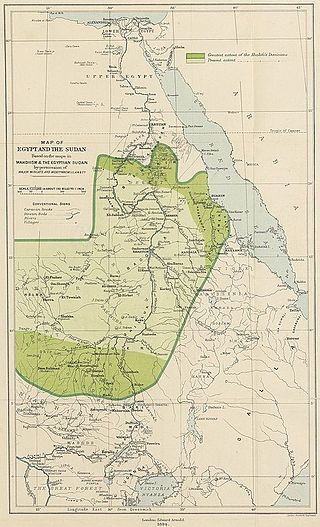
The Anglo-Egyptian conquest of Sudan in 1896–1899 was a reconquest of territory lost by the Khedives of Egypt between 1884 and 1885 during the Mahdist War. The British had failed to organise an orderly withdrawal of Egyptian forces from Sudan, and the defeat at Khartoum left only Suakin and Equatoria under Egyptian control after 1885. The conquest of 1896–1899 defeated and destroyed the Mahdist State and re-established Anglo-Egyptian rule, which remained until Sudan became independent in 1956.
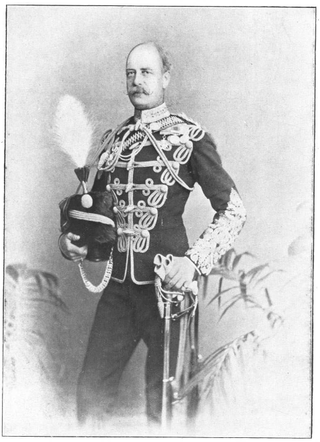
Edward Alexander Wood was an English first-class cricketer and British Army officer. Wood was a career soldier in the 10th Royal Hussars, rising to the rank of major-general. He fought in both the Second Anglo-Afghan War and the Mahdist War, with Wood being made a Companion to the Order of the Bath for his service in the latter. He was also a first-class cricketer, appearing in one match in 1875.
El Teb by J Hamid. The book is centered on the battle of El Teb and a rifle captain in the Kings Royal Rifle Corps and his company during the conflict.
